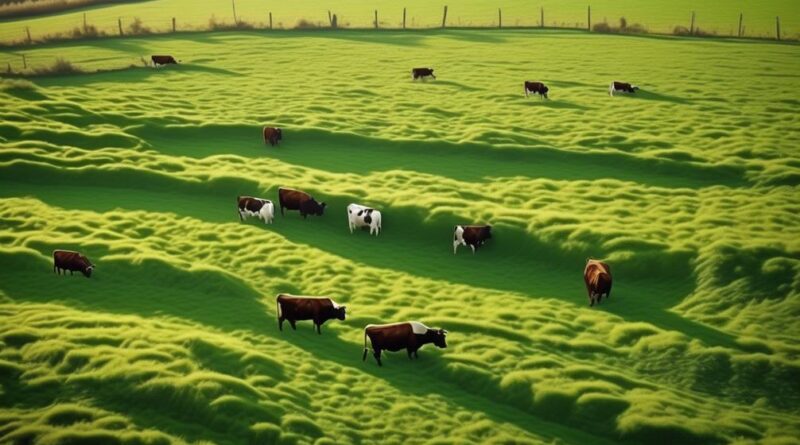Effective Grazing Techniques for Increased Cattle Productivity
Are you looking for ways to improve your cattle productivity through more effective grazing techniques?
The key to maximizing cattle productivity lies in the management of grazing systems, and there are several techniques that have been proven to significantly increase the overall productivity of cattle.
By implementing these techniques, you can not only improve the health and well-being of your cattle but also enhance the sustainability of your grazing operation.
But how exactly can you achieve this?
Keep on reading to find out how these effective grazing techniques can transform your cattle productivity and ultimately benefit your bottom line.
Rotational Grazing
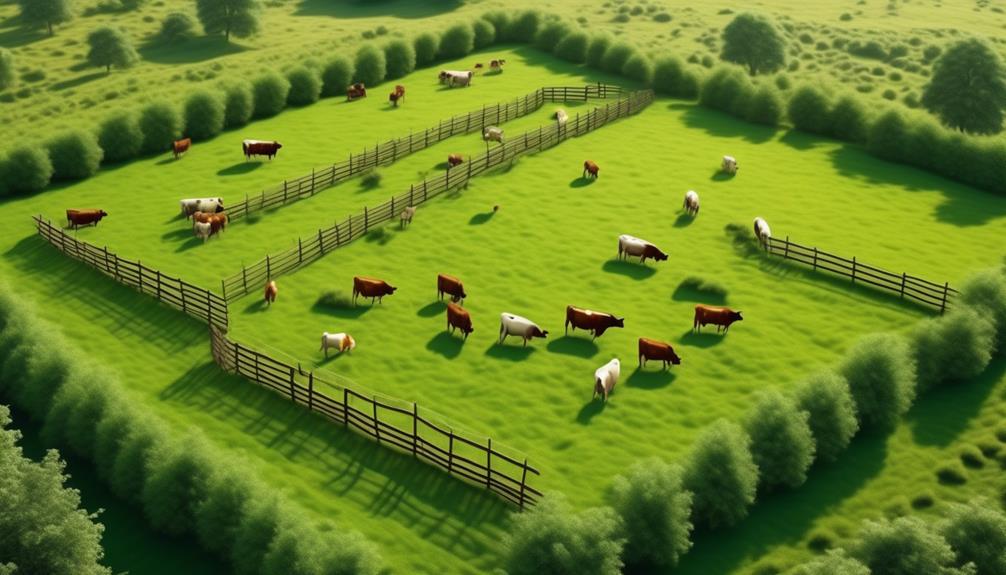
Looking to maximize your cattle's grazing potential while maintaining pasture health and productivity? Consider implementing rotational grazing techniques.
Grazing management is crucial for ensuring that your cattle have access to high-quality forage while preventing overgrazing. With rotational grazing, you divide your pasture into smaller paddocks and rotate your cattle through them at regular intervals. This allows for more efficient forage utilization and promotes healthier pastures.
By practicing rotational grazing, you can ensure that your cattle have access to fresh, high-nutrient forage. As they move to a new paddock, the previously grazed areas have time to recover and regrow, leading to improved forage quality and quantity. This method optimizes forage utilization by preventing selective grazing and trampling. Additionally, it helps to break parasite cycles, as the larvae are left behind in the resting paddocks and are unable to infest the cattle.
Effective grazing management through rotational grazing also contributes to better pasture health. It minimizes soil compaction and erosion, as the rest periods allow the soil to recover. This, in turn, enhances the overall productivity and resilience of the pasture.
Implementing rotational grazing techniques is an efficient way to balance your cattle's nutritional needs with the health and sustainability of your pasture. By managing grazing in this manner, you can significantly improve your cattle's productivity while maintaining a thriving pasture ecosystem.
Strip Grazing
Consider implementing strip grazing as a method to maximize forage utilization and promote efficient cattle productivity within your pasture. Strip grazing involves dividing your pasture into smaller sections and allowing cattle access to one section at a time for a specific period. This technique offers several benefits that can significantly impact your overall herd management and pasture health.
- Reduced Wastage
By restricting cattle access to a small strip at a time, you can minimize trampling and soiling of the forage, reducing wastage and ensuring that more of the available forage is consumed.
- Increased Forage Utilization
Strip grazing encourages cattle to graze more evenly across the pasture, leading to better utilization of the available forage. This can result in increased productivity per acre of pasture.
Implementing strip grazing can also have positive effects on soil health. The controlled grazing patterns can promote better nutrient distribution and reduce soil compaction. Additionally, the rest periods for each grazed strip allow forage to recover, leading to improved regrowth and sustained productivity.
Furthermore, this technique can lead to animal welfare improvements as it provides a more structured and consistent grazing environment. Cattle are less likely to overgraze or underutilize the available forage, leading to healthier and more contented animals.
Targeted Grazing
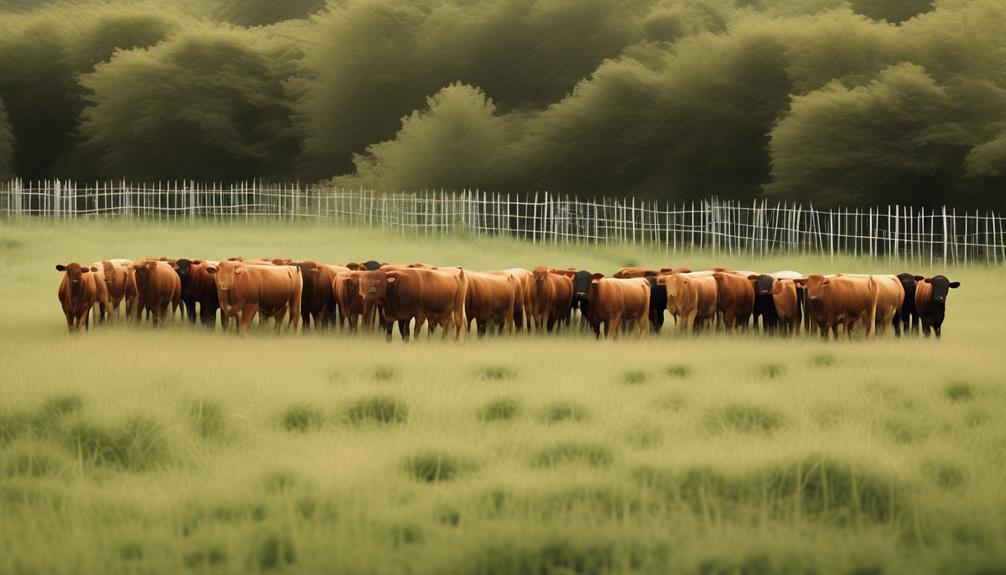
How can targeted grazing optimize cattle forage consumption and pasture management?
Targeted grazing can significantly improve grazing efficiency and forage utilization. By strategically directing cattle to specific areas within the pasture, you can ensure that they graze more evenly, reducing overgrazing in some areas and underutilization in others. This method allows for better control over vegetation height and density, leading to improved forage quality and quantity.
Implementing targeted grazing involves understanding the specific forage needs of your cattle and the condition of the pasture. By focusing grazing in certain areas for a defined period, you can manage vegetation growth and maintain a more balanced pasture ecosystem. This approach not only benefits the cattle but also contributes to pasture health and sustainability.
When using targeted grazing, it's essential to monitor the impact on the vegetation and soil to avoid overgrazing. By rotating the grazing areas, you can give plants time to recover and regrow, promoting a healthier and more diverse pasture. This method can also be particularly useful for controlling invasive plant species and promoting the growth of desirable forage.
Managed Intensive Grazing
To increase cattle productivity and pasture sustainability, implementing managed intensive grazing can significantly optimize forage consumption and vegetation management. This approach involves dividing pastures into smaller paddocks and rotating cattle through them at high stocking densities for short periods.
Here's why managed intensive grazing is a game-changer for grazing management and soil health:
- Enhanced Forage Utilization: By concentrating cattle in smaller areas for limited durations, managed intensive grazing ensures more even and thorough forage consumption. This prevents overgrazing in some areas and underutilization in others, leading to improved pasture productivity.
- Increased Soil Fertility: The intense hoof action and trampling of forage during managed intensive grazing help incorporate organic matter into the soil. This stimulates microbial activity, enhances nutrient cycling, and improves soil structure, ultimately boosting soil health and fertility.
- Vegetation Management: Controlled, high-density grazing followed by adequate recovery periods can effectively manage vegetation composition and density. This promotes diverse plant species, reduces weed encroachment, and encourages desirable forage growth, contributing to overall pasture health and resilience.
Incorporating managed intensive grazing into your grazing management strategy can lead to more efficient forage utilization, healthier pastures, and improved soil health. By carefully managing grazing intensity and duration, you can foster a balanced ecosystem that supports both cattle productivity and long-term sustainability.
High Stock Density Grazing
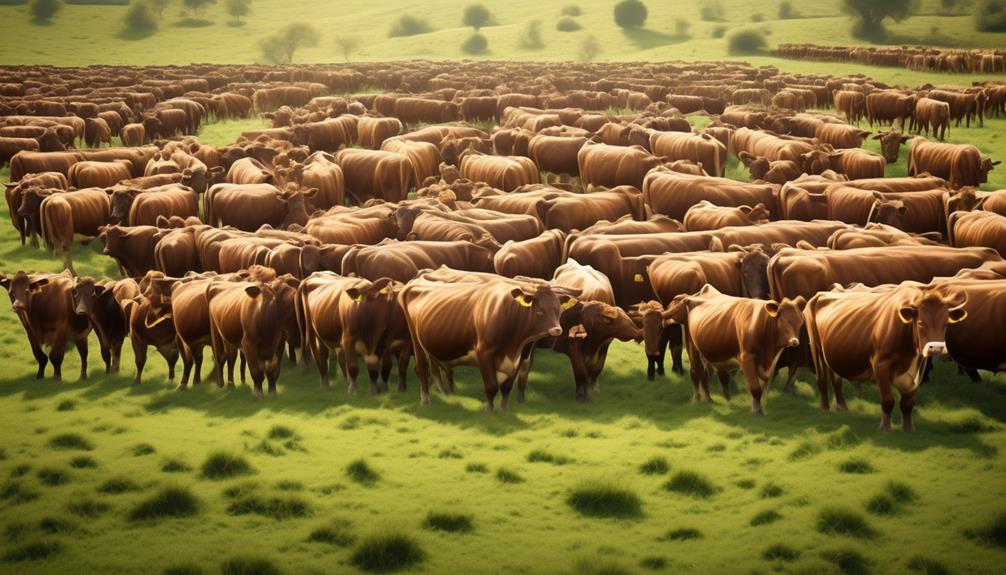
Implementing high stock density grazing can revolutionize your cattle management practices and pasture productivity. This technique involves concentrating a large number of cattle in a small grazing area for a short period. The result is a significant impact on soil health and forage quality.
High stock density grazing benefits soil health by promoting better nutrient distribution and increased organic matter decomposition. As cattle trample and manure the land more intensely in a smaller area, it encourages soil aeration and incorporation of organic matter, fostering overall soil health and productivity.
Moreover, this grazing method also positively influences forage quality. By intensely grazing a small area, cattle consume a higher proportion of the available forage. This, in turn, leads to more uniform forage height and reduced selective grazing. As a result, there's a more balanced utilization of forage species, which contributes to improved forage quality and regrowth. The increased trampling of plant material also aids in the natural breakdown of old forage, promoting nutrient cycling and creating a more favorable environment for new growth.
Incorporating high stock density grazing into your cattle management strategy can lead to enhanced soil health and improved forage quality. This approach offers a sustainable method to maximize pasture productivity while maintaining the health of both the soil and the herd.
Multi-Species Grazing
Consider incorporating multi-species grazing into your cattle management strategy to maximize pasture productivity and promote ecological balance. By introducing different types of livestock onto your grazing land, you can significantly improve the overall health of the ecosystem and enhance the productivity of your herd.
Here's why multi-species grazing is a beneficial practice:
- Species Interaction
- *Complementary Grazing Habits*: Integrating cattle with smaller livestock such as sheep or goats allows for more efficient use of forage. While cattle primarily consume grass, sheep and goats are more inclined to browse on shrubs and weeds. This complementary grazing behavior ensures a more uniform use of pasture resources, preventing overgrazing in specific areas and promoting a healthier, more diverse plant community.
- *Parasite Control*: Some species, like goats, are natural browsers and tend to consume a wider variety of plants. By doing so, they can help reduce the presence of certain parasites that are harmful to cattle. This mutual interaction aids in controlling the spread of parasites within the grazing environment.
- Ecosystem Benefits
- *Improved Soil Fertility*: Different species have varying impacts on the soil. For instance, the hoof action of cattle can help incorporate organic matter into the soil, while the grazing behavior of sheep and goats can promote better nutrient distribution. This diverse environmental influence can lead to improved soil fertility and overall pasture health.
- *Biodiversity Enhancement*: Multi-species grazing encourages a more diverse and resilient plant community. As various livestock species interact with different plant species, it promotes a healthier and more balanced ecosystem, ultimately benefiting the overall biodiversity of the grazing area.
Incorporating multi-species grazing into your cattle management approach not only enhances pasture productivity but also fosters a more sustainable and ecologically balanced environment.
Adaptive Multi-Paddock Grazing
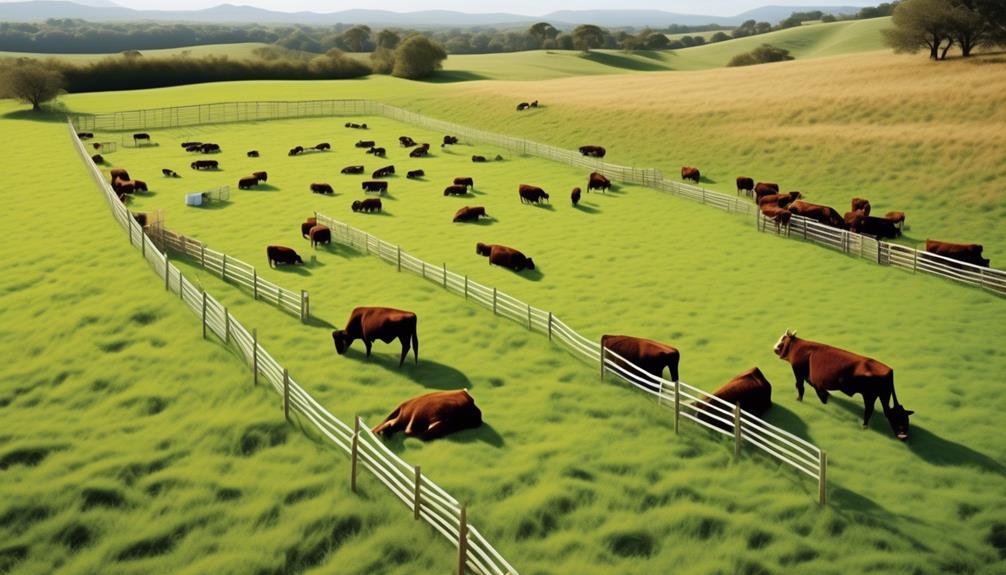
Integrating the principles of multi-species grazing, such as complementary habitat utilization and biodiversity enhancement, can be further optimized through the implementation of adaptive multi-paddock grazing for increased cattle productivity. Adaptive multi-paddock grazing is a key component of holistic land management, offering numerous benefits for both livestock and the environment. This approach involves dividing pastures into smaller paddocks and rotating cattle through them in a strategic and flexible manner.
By using adaptive grazing systems, you can better manage the distribution of cattle across the land, which can prevent overgrazing and promote more uniform utilization of forage. This not only supports the health of the pasture but also enhances soil fertility and reduces erosion. Through the strategic movement of cattle from one paddock to another, you can also encourage the natural regeneration of vegetation, leading to improved biodiversity and habitat quality.
Furthermore, adaptive multi-paddock grazing allows for better control over grazing pressure, which can lead to increased forage production and better quality forage. This, in turn, can result in improved cattle performance, including enhanced weight gain and overall productivity. By actively managing the grazing patterns, you can optimize the utilization of available forage, leading to improved efficiency and profitability in cattle operations.
In essence, the implementation of adaptive multi-paddock grazing as part of holistic land management presents an opportunity to optimize cattle productivity while simultaneously promoting environmental sustainability.
Seasonal Grazing Rotation
To optimize cattle productivity and pasture health, seasonal grazing rotation is an effective strategy for managing forage resources throughout the year. By implementing seasonal grazing rotation, you can achieve several key benefits:
- Grassland Regeneration and Soil Health
Allowing pastures to rest during specific seasons encourages grassland regeneration, preventing overgrazing and promoting healthier soil. This practice fosters deeper root growth and enhances soil structure, leading to improved water infiltration and carbon sequestration.
- Forage Quality and Animal Nutrition
Seasonal grazing rotation enables better control over forage quality. By rotating cattle to different pastures based on the season, you can ensure that they have access to a variety of forage types, leading to a more balanced and nutritious diet. This approach also helps to prevent selective grazing, where cattle preferentially consume certain forage species, ensuring a more even utilization of the available forage.
Implementing seasonal grazing rotation not only benefits the cattle and the land but also supports long-term sustainability. By strategically rotating cattle through pastures based on the season, you can effectively manage forage resources, promote grassland regeneration, and maintain soil health.
Furthermore, this approach allows for improved forage quality, supporting better animal nutrition and overall productivity.
Frequently Asked Questions
How Can I Determine the Ideal Stocking Rate for My Specific Grazing Area?
To determine the ideal stocking rate for your grazing area, analyze the vegetation, soil, and climate to understand the carrying capacity. Regular monitoring and adjustments based on forage availability are crucial for sustainable cattle productivity.
What Are Some Common Challenges or Obstacles That Can Arise When Implementing These Grazing Techniques?
When implementing grazing techniques, common challenges include overgrazing management and grazing land restoration. It's essential to maintain livestock nutrition and soil fertility. Keep a close eye on these factors for sustainable cattle productivity.
Are There Any Specific Tools or Technologies That Can Help With Managing and Monitoring Grazing Rotations?
To manage and monitor grazing rotations, you can use monitoring technologies and grazing management tools. These tools can help you track cattle movement, optimize grazing patterns, and ensure sustainable land use for increased cattle productivity.
How Can I Effectively Transition From Traditional Grazing Methods to More Intensive Rotational Grazing Systems?
Transitioning from traditional grazing to intensive rotational systems can present challenges, but technology tools like GPS trackers, soil monitors, and electric fencing can help. These tools enable better land management and increased cattle productivity.
What Are Some Potential Economic Benefits of Implementing These Grazing Techniques, and How Can I Measure Their Impact on Cattle Productivity?
You can measure the economic benefits of new grazing techniques by conducting a cost benefit analysis. Track productivity metrics like weight gain and reproductive rates for performance indicators. This data will help assess the impact on cattle productivity.
Conclusion
In conclusion, by implementing effective grazing techniques such as rotational grazing, strip grazing, and targeted grazing, you can significantly increase cattle productivity.
Managed intensive grazing, high stock density grazing, and multi-species grazing also offer opportunities for improved results.
Consider adopting adaptive multi-paddock grazing and seasonal grazing rotation to further maximize the benefits of your grazing practices.
With the right approach, you can ensure the health and productivity of your cattle while promoting sustainable land management.
